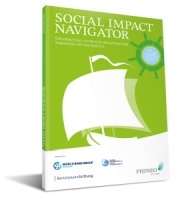Social Impact Navigator
Planning ahead for what happens afterwards
Social Impact Navigator: Reach project goals more effectively
Social Impact Navigator: Reaching project goals more effectively
The success of social projects is measured by how much impact a project has — both for the target groups and for society as a whole.
The Social Impact Navigator helps you to …
- plan your project with the greatest possible impact right from the start,
- precisely define goals and target groups,
- develop an impact logic for your project,
- analyze and “measure” the impact achieved,
- communicate and market your project to the appropriate audience
But the Social Impact Navigator can do much more than just project management: it also supports you in your fundraising! If you can demonstrate plausibly how your project works and what successes it achieves, you have good prospects for potential donors.

Downloads
- Download Social Impact Navigator
- Download Social Impact Navigator (Spanish)
- Download Social Impact Navigator (Italian)
- Click here for the german Version …
The Social Impact Navigator explains step by step in a clear and understandable way how the often hectic everyday life of a project can be organised more systematically. With examples, tools and checklists.
And best of all: the Social Impact Navigator is free of charge. Online and in print.
Project management for associations
The Social Impact Navigator is a joint project of the Bertelsmann Stiftung and PHINEO. The Social Impact Navigator was first published in 2013. Since then, 40,000 copies have been distributed, both online and in print.
The Social Impact Navigator helps to put project management in associations on a solid ground:
- Needs assessment and context analysis: Successful project management requires precise knowledge of the needs of the target groups. For the structure and the planning of a project, you need to know who is already working in the project field and which offers you could use to fill gaps.
- Defining target groups: A nonprofit project is only successful if it effectively reaches the target groups. As trivial as this may sound: in practice target group analyses are often very vague.
- Defining impact objectives: No project without a goal! Impact objectives are the foundation for effective project management in associations & NGOs. They specify which measures have to be taken and which processes have to be installed to reach the target groups.
- Finding indicators: In order to determine whether the impact has occurred as foreseen in the project plan, clues are needed,called indicators.
- Measuring impact: The achieved impact can be planned and “measured” or rather analyzed. This may not be a key figure, but it can be done in such a way that you can find out how well you “make an impact”.
- Creating an impact logic: What is the logic behind the project, which stages build upon on each other? An impact logic helps you to set upthe structure and planning of a project in such a way that resources are used in an optimal way.
- Monitoring & data collection: There are countless methods of data collection. Among them are some that associations can implement on their own.
- Communication: Transparent communication with sponsors, cooperation partners and the public does not only appear credible, but also contributes to the quality management, because you can identify deviations from the plan more quickly.
You will find this and much more in the Social Impact Navigator. You can download it at the upper part of the page.
- For the online version please click here: “Social Impact Navigator projekt management for associations” (in german) …
- Our workshops & web-seminars on the topics of impact orientation, project planning and impact measurement
- For foundations and sponsors: The Foundation Navigator – Creating impact-oriented funding projects
How can I help you?
Jonas Fathy
